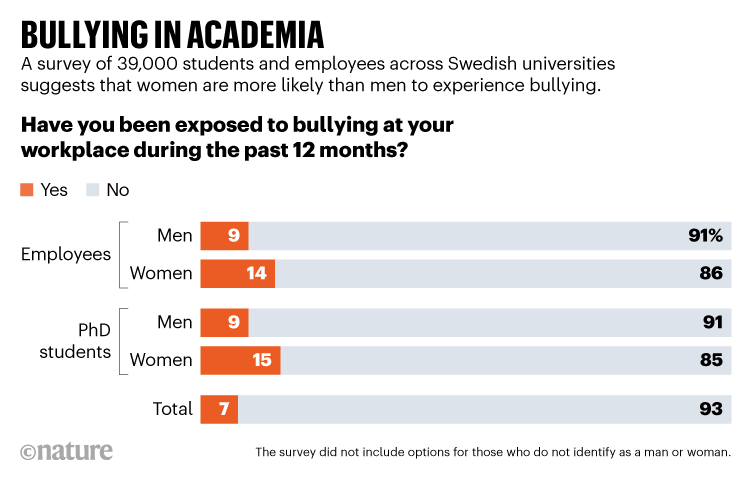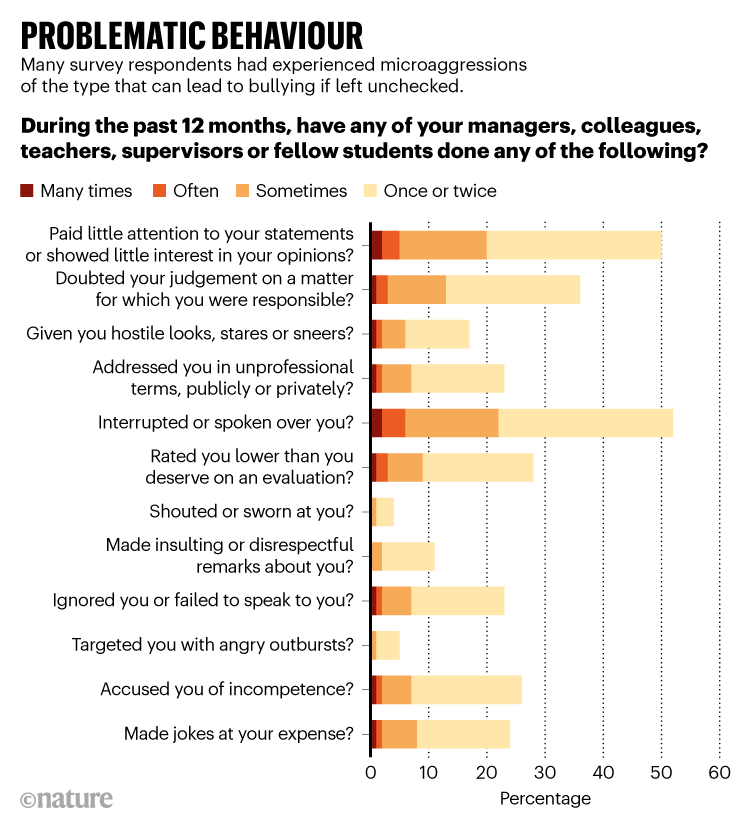One in 15 people studying or working at Swedish universities has experienced bullying over the past year, according to the largest-ever nationwide survey of academic workplace culture.
The results, which included responses from people at all of Sweden’s 38 higher-education institutions, reveal that women and young researchers are the worst affected, with one in 7 female PhD students saying that they had been bullied over the past 12 months.
Similar patterns are likely to be seen in other countries with comparable research systems, such as the United Kingdom or United States, says Matthew Martin, a researcher at West Virginia University in Morgantown who studies bullying. He adds that, in general, women are more often the target of bullying and sexual harassment than men.
Bullying and harassment in science have come under increasing scrutiny in recent years because of wider public-awareness campaigns, such as the global #MeToo movement, through which huge numbers of women spoke up about their experiences of sexual harassment. Research funders are also placing a greater emphasis on cultivating workplace cultures that deter such behaviours through the introduction of official anti-bullying policies. Since 2018, at least two high-profile researchers in Europe have had their funding withdrawn after investigations by their institutions found evidence of bullying.
Nationwide survey
To get a handle on the prevalence of bullying and sexual harassment at Swedish universities, a group of researchers sent a survey to a sample of university students and employees, to ask about their experiences. The team, led by Christina Björklund, who studies bullying at the Karolinska Institute in Solna, Sweden, received almost 39,000 responses between May and July 2021. A report outlining the findings was published in May.
“It is the largest survey [of its kind] globally,” says Fredrik Bondestam, a researcher in gender-based violence at the University of Gothenburg in Sweden, who sat on the steering board of the study and helped to design the research.
Across all staff members and students, 7% of respondents said that they had experienced bullying over the past 12 months, rising to 14% for female employees and 15% for female PhD students (see ‘Bullying in academia’). The proportions of affected researchers and administrative staff members were 12% and 10%, respectively (there was no breakdown by gender for these groups). Rates of bullying in Sweden across the entire working population are around 10%.
The survey took place when many universities encouraged employees to work from home because of the COVID-19 pandemic, so the researchers also asked about cyberbullying. Around 5% of respondents said that they had experienced work-related bullying on social media, by e-mail or in text messages.
Of the entire group, 4% of respondents said that they had experienced sexual harassment over the past year, with male university employees and male PhD students reporting such experiences at half that rate. Björklund says that among all working people in Sweden, the rate of sexual harassment is about 3%, according to surveys. Around half of those who experienced sexual harassment in academia said that they had told someone about their experiences, but just 12% reported the behaviour through formal channels.
Interrupted and ignored
The researchers also asked about how often respondents had experienced types of microaggression — such as being interrupted or spoken over, ignored or shouted at — that, if left unchecked, can lead to a working environment in which bullying and harassment are tolerated.
More than 95% of respondents said that they had never been shouted or sworn at, but 50% said that they had experienced situations in which their contributions or opinions were not given attention. One-fifth said that they were often or sometimes interrupted or spoken over (see ‘Problematic behaviour’).
These incivilities matter, says Björklund. “If you are interrupted all the time, what will happen to your opinions?” she asks. “We can see that if you have a good, inclusive work environment with support, it is related to higher performance, you will get more research money and write more publications,” she adds.
Before the release of the survey results, there were limited large-scale data on the prevalence of bullying and sexual harassment in the higher-education system of any country. In January, the government department responsible for science in Ireland published the results of a nationwide survey on sexual harassment sent to all university employees and students, which garnered around 11,500 responses. It found that almost one-quarter of staff members had experienced sexualized comments and one-third had been the target of sexist remarks.
The European Union is also conducting a large study to help policymakers to understand the prevalence of sexual harassment and gender-based violence in universities and research organizations, on which it will report later this year.
Bondestam says that the Swedish team invited responses from a large number of university employees and students to ensure that the study had representative data, to ward off criticism from people who do not think that these problems exist at universities. “We wanted to be able to say ‘this is the data — don’t mess with the figures’.”










More News
Chemoproteomic discovery of a covalent allosteric inhibitor of WRN helicase – Nature
Single-cell analysis reveals context-dependent, cell-level selection of mtDNA – Nature
A high-density and high-confinement tokamak plasma regime for fusion energy – Nature